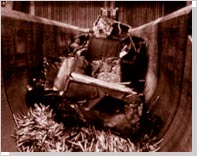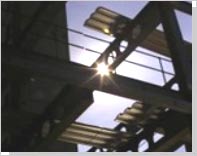 Iron and steel is a valuable feedstock in producing new steel products. The huge quantities of iron and steel produced over a long period, dating back to 19th century, has helped in developing a secondary industry of scrap processing.
Iron and steel is a valuable feedstock in producing new steel products. The huge quantities of iron and steel produced over a long period, dating back to 19th century, has helped in developing a secondary industry of scrap processing.
The steel and iron scrap can be categorized into three main categories, viz. "home", "new" and "old". Technological advancements have considerably reduced the generation of home scrap. New or prompt scrap is generated in manufacturers' plants and includes items, such as stampings, turnings, and clippings. Old or obsolete scrap is referred as iron or steel from post consumer products, such as appliances, automobiles, bridges and buildings.
An essential requirement in scrap recycling is to maintain the quality of steel products by minimizing the contamination with other metals. Potential metal contamination may stem from the recycling of automobiles and other metals.
Some common grades of iron and steel scrap include - heavy metal steel, plate and structured steel, hydraulic silicon bundles, short shoveling steel turnings, machine shop turnings, cast iron borings, mixed turnings and borings, shredded scrap, mixed cast, steel turnings and foundry steel. Some common types of iron and steel intermediary products, include - steel making slag, spent pickle liquor, flue dust, filter cake, waste sludge and mill scale.
Steel / Iron Recycling - Some Important FactsSteel is a unique material as it always contains recycled steel. Every year, million of tons of pre- and post-consumer steel products, including used steel cans, automobile and construction materials, appliances, are recycled by steel mills into every ton of new steel manufactured. In fact, with the exception of the earliest methods of steel making, recycling has always been an integral part of the production of steel.
In addition, all new steel products made from recycled steel can be recycled again and again at the end of their useful lives. Waste steel cans are recycled into part of a guard rail that may one day be recycled into an appliance. Ferrous scrap processors are there in the market to prepare all types of steel products for recycling. These processors develop and ship steel scrap to steel mills and foundries for remelting into new steel.
Electronic Scrap Recycling - Associations- Using recycled steel helps save 74 % of the energy as opposed to producing them from raw material.
- Steel recycling saves enough energy, which is equivalent to electrically power 1/5 of all homes in the U.S.
- On an average, a little more than 9,000 steel cans are removed from landfills with a magnet every minute.
- Food cans generally contain a tin coating that is a valuable metal. 70% to 80% of this tin is recovered while recycling the food cans.
- With around 60% of all steel recycled, it is the most recycled material.
- Some most popular items include - automobiles, food cans, and appliances. All these items usually contain a minimum of 25% recycled steel.
Grades
Different grades and varieties of steel and iron scrap are used for recycling purposes and to recover pure steel from the scrap. Given in the table below are some of the important grades / types of steel / iron used in recycling.
Recovery ProcessAccording to reports, iron and steel constitute over 90% of the production of all metals and a similar fraction of the scrap metals market. Steel mills consume about 3/4 of all scrap, and iron and steel foundries consume the remaining to produce ferrous castings.
Developments in technology has influenced the ability of steel plants to accept scrap inputs. From the start of century until the 1950's, the Open hearth Furnace dominated the steel making process. The method primarily uses pig iron, but could accommodate more than 50% scrap in its mix because of the use of an external heat source. The succeeding technology, the Basic Oxygen Furnace (BOF) process was introduced in 1952 and has undergone various developments such as the Q-BOP (bottom-injected) oxygen converter. Today BOF processes account for about 60% of the total steel production in US. The principal feed of the BOF is molten pig iron from the blast furnace. As a matter of fact, most of the scrap used in BOF's comes from the mill itself.
The Electric Arc Furnace (EAF) , developed commercially for the melting of iron and steel scrap in the mid 1960s, accounts for a significant portion of the steel produced across the world. The technique is based on the use of electricity conveyed by graphite electrodes to melt scrap and can accommodate 100% scrap in the feed. This technique is sensitive to the presence of residual elements, such as zinc, chromium, copper, and molybdenum that can cause defects in the finished steel at levels evaluated in tens of parts per million.
Steel & Iron Recycling - Future Outlook Steel & Iron Recycling Consumption of ferrous scrap and the growth or decline of the scrap industry depends heavily on the health of the steel making industry. According to experts, most regions of the world will see a marked increase in steel consumption during the next few years. In some parts of the world, a growing economy with a steadily increasing population has ensured that the demand for steel products, and the scrap used to produce them will also increase in long run.
Steel & Iron Recycling Consumption of ferrous scrap and the growth or decline of the scrap industry depends heavily on the health of the steel making industry. According to experts, most regions of the world will see a marked increase in steel consumption during the next few years. In some parts of the world, a growing economy with a steadily increasing population has ensured that the demand for steel products, and the scrap used to produce them will also increase in long run.
The consumption of iron and steel scrap for producing quality metal will continue to be in strong demand in the automotive and consumer appliance sectors. The use and application of steel framing is increasing in the development of retirement homes, multifamily developments and single-family residences. Demand of steel in can production that includes aerosol cans, and paint is expected to remain strong in the long run. A thriving steel industry depends on plentiful inexpensive energy. With increasing energy costs, the demand for steel pipe and tubular goods for uses in oil and gas industry will increase for new drilling projects. Foundries are a crucial market for tin-bearing scrap from recycled cans.
E-commerce has been making progress at varying rates in the steel industry, as well as other sectors of the economy. Selling scrap through e-commerce has potential, however the adoption of e-commerce marketing by the ferrous scrap industry will expected to be a slow evolutionary process. For e-commerce to be adopted, it is necessary for the scrap processors, dealers, and brokers to realize the value of this modern Internet technology and see potential gains in profits and efficiency.
An important problem for the world currently is the production of too much steel. In most parts of the world, the steel making capacity is excessive relative to demand, sometimes as high as 15 % more than can be consumed. As profits decline, companies continue to expand production by about 2 % every year. This excess steel production has been resulting in falling steel prices and declining scrap demand and prices.
